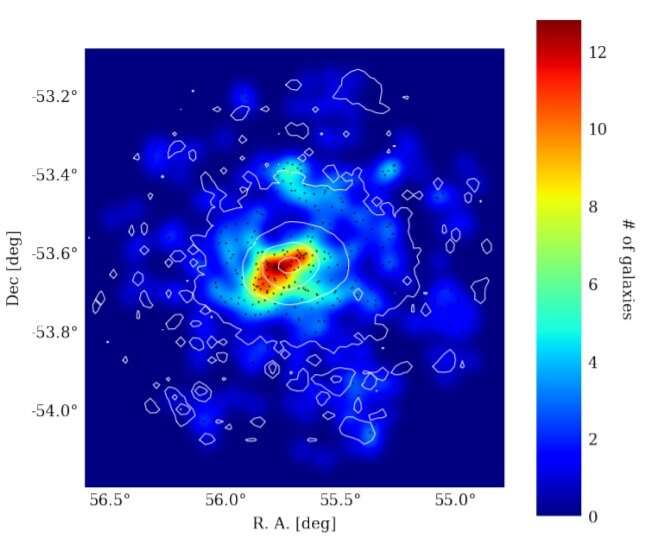Galaxy density map with members of Abell 3158. Credit: Whelan et al., 2021.
Astronomers from the University of Bonn, Germany and elsewhere have used the eROSITA telescope onboard the Spektrum-Roentgen-Gamma (SRG) mission to perform X-rays observations of a nearby galaxy cluster known as Abell 3158. Results of this observational campaign, published June 28 on arXiv.org, offer more clues on the properties of this giant structure.
Galaxy clusters contain up to thousands of galaxies bound together by gravity. They are the largest known gravitationally bound structures in the universe, and could serve as excellent laboratories for studying galaxy evolution and cosmology.
At a redshift of 0.059 and characteristic radius of approximately 23.95 arcminutes, Abell 3158 (or A3158 for short) is a quite extended nearby galaxy cluster. Given its relative proximity, Abell 3158 is a good place to examine the faint outskirts where physical and enrichment processes are taking place, such as minor mergers or infall of gas clumps.
A team of astronomers led by Béibhinn Whelan of the University of Bonn, has employed eROSITA to investigate the peripheral regions of Abell 3158 in order to shed more light on the properties of this object. The study was complemented by data from ESA's XMM-Newton satellite.
"We determined 1d temperature, abundance and normalisation profiles from both eROSITA and XMM-Newton data, as well as 2D maps of temperature and metal abundance distribution from eROSITA data," the researchers wrote in the paper.
The overall temperature of Abell 3158 was measured to be about 4.725 keV. The astronomers noted that temperature, abundance and normalisation profiles of eROSITA are consistent with previous studies of this cluster.
The eROSITA data provided tighter constraints on the metal abundance of Abell 3158 out to large radii. According to the paper, the normalisation profile shows that the values obtained from the XMM-Newton observation are slightly higher than those from eROSITA.
The study found that the morphology and surface brightness profile of Abell 3158 seem to be regular. However, the 2D temperature map of Abell 3158 shows that the cluster does not have a cool core, what is unusual for a cluster with such a surface brightness profile.
Furthermore, based on the spectroscopic redshifts of 365 members of Abell 3158, the velocity dispersion of the cluster member galaxies was measured to be some 1,058 km/s. The total mass of the cluster was calculated to be 1.38 quadrillion solar masses.
The research also identified an extension of gas some 2.2 million light years in the west direction from the center of Abell 3158. This finding suggests that the cluster is not relaxed but is undergoing merger activity.
"There exists an extension of gas ∼10 arcmin (∼865 kpc) to the West of the cluster centre, observed in the bottom image in the logarithmic scale. We present this extension of gas as a new finding. The irregularities between the different scales would suggest that there may be a sloshing effect occurring in the cluster further supporting the claim that the cluster is undergoing merger activity," the authors of the paper concluded.
More information: X-Ray Studies of the Abell 3158 Galaxy Cluster with eROSITA, arXiv:2106.14545 [astro-ph.CO] arxiv.org/abs/2106.14545
© 2021 Science X Network
























